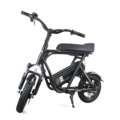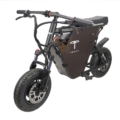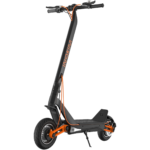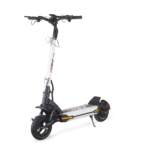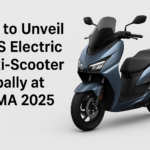- Home
- Scooters
- Electric Scooters
- EMOVE Cruiser S
EMOVE Cruiser S
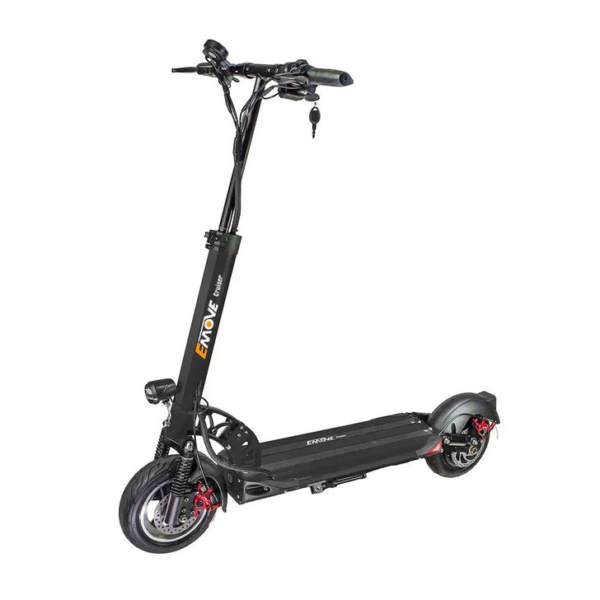

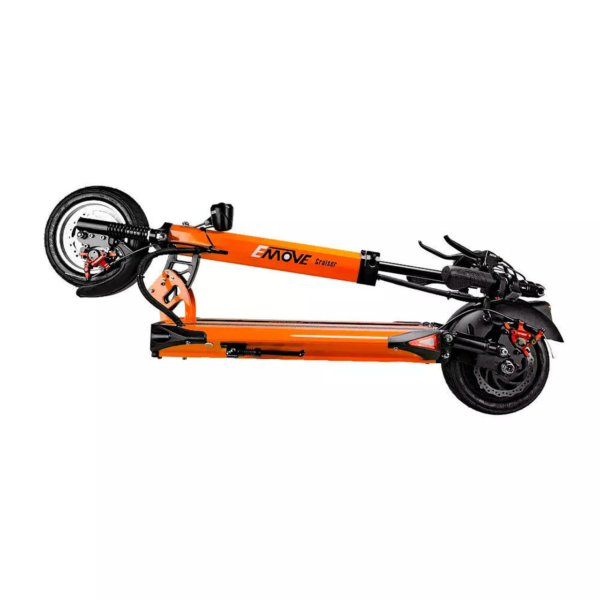
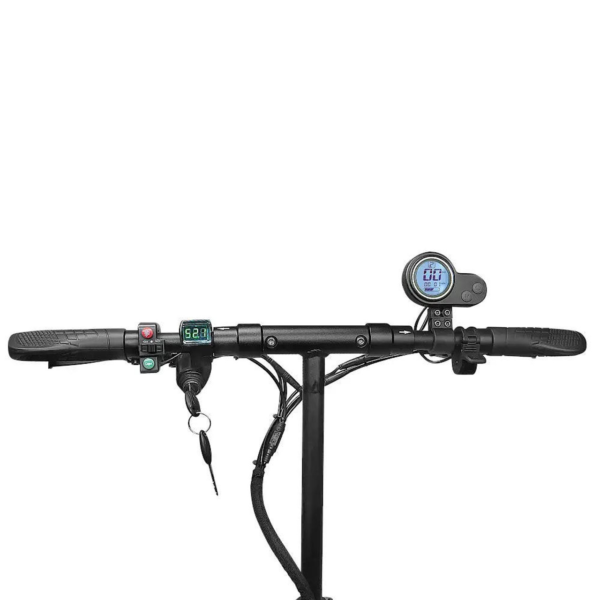
- Battery Range: 62 miles (100 km)
- Top Speed: 32 mph (51.5 km/h)
- Motor Power: 1000 W
- Weight Capacity: 330 lb (150 kg)
- Charging Time: ~9–12 h
- Scooter Weight: 56.0 lb (25.4 kg)
PROS
- 62-mile range 52V 30Ah (1,560 Wh)
- 10″ × 3″ tubeless pneumatic tires
- IPX6 water resistance
- XTECH hybrid hydraulic disc brakes
- Adjustable telescoping handlebars
CONS
- Heavy for commuting (56 lb)
- No Bluetooth app
- Dimensions not specified officially
- Speed limited to ~20 mph in some regions out of box
Key Takeaways
- The EMOVE Cruiser S is a long-range, single-motor commuter scooter designed for daily use and easy maintenance.
- It features a 1000 W rear hub motor, 52 V, 30 Ah battery, tubeless tires, and hydraulic brakes, delivering a smooth ride.
- With a top speed of 32 mph and a range of up to 62 miles, it’s ideal for commuters and multi-modal riders.
- Riders benefit from features like a bright LCD display, electronic braking, and a solid construction that includes IPX6 water resistance.
- The EMOVE Cruiser S suits those seeking reliable performance and comfort, particularly for daily commutes or short trips.
Table of contents
- What Is the EMOVE Cruiser S?
- How the EMOVE Cruiser S Works
- Key Specifications
- Design & Build Quality
- Performance Fundamentals
- Battery, Range & Efficiency
- Ride Quality & Comfort
- Braking & Safety Features
- Portability & Daily Usability
- Maintenance & Care
- Weather & Seasonal Considerations
- EMOVE Cruiser S vs Alternatives
- Who the EMOVE Cruiser S Is (and Isn’t) For
- FAQs
- Glossary
- Final Notes for Owners
The EMOVE Cruiser S is a long-range, single-motor commuter that feels built for real life. It pairs a big battery with tubeless tires and a smooth sine-wave controller, so daily rides stay simple and calm. The setup suits riders who want dependable range, clear controls, and sturdy parts based on official specifications. If you’re comparing siblings, the newer EMOVE Cruiser V2 sits close on features. And if you want a different take with a cruiser vibe, the MotoTec Cruiser points in another direction.
It fits commuters, students, and weekend riders who rack up miles. And it stays friendly for first-time owners who want clean settings and easy care. So the EMOVE Cruiser S ends up as a straight-shooting choice for everyday use.
What Is the EMOVE Cruiser S?
The EMOVE Cruiser S is the latest step in a well-known line. It keeps the core recipe of a 52 V, 30 Ah battery and a 1000 W rear hub motor, and it adds a sine-wave controller, a white LCD, and a thumb throttle. So the power comes in smooth, the display stays readable in daylight, and your right hand relaxes on long rides. You also get IPX6 water resistance, tubeless 10 in × 2.75 in air tires, and XTECH hybrid hydraulic brakes with 140 mm rotors. Lights, turn signals, and deck lighting come in the box.
You can fold the stem, and you can fold and telescope the bars. So the scooter slides under a desk or into a trunk. It carries up to 330 lb (150 kg) and weighs about 56 lb (25.4 kg). That weight lands in the carryable range for short stairs, and it still buys you range that matters.
How the EMOVE Cruiser S Works
Think of the Cruiser S as five parts that play well together.
Motor. A 1000 W rear hub does the pushing. The motor sits in the wheel, so the drive stays quiet and clean with no chain or belt. You feel steady torque from a stop, and rear-wheel traction helps on dust or grit.
Controller. A sine-wave unit meters power in gentle steps. So small throttle moves give small speed changes, and tight spaces feel easier. The controller also enables electronic braking through the motor, which adds drag when you squeeze the levers. Then you can dial that in the menu.
Battery. A 52 V, 30 Ah pack with LG 18650 cells sits inside the deck. That equals about 1560 Wh of energy. So you can stack real distance before hunting for a wall socket.
Throttle and display. The white LCD reads clean in sun, and the vertical thumb throttle keeps your wrist neutral. Long cruise speeds feel natural, and small bumps don’t jolt your grip.
Brakes. XTECH hybrid hydraulic calipers clamp 140 mm rotors front and rear. You pull a cable at the lever, and hydraulic pistons in the calipers do the heavy work. So bite comes early, and you need less finger force to slow down. Electronic braking layers on more as you like.
Key Specifications
These specifications reflect the current EMOVE Cruiser S. Values show imperial first, then metric.
General
| Item | Value |
|---|---|
| Model | EMOVE Cruiser S |
| Year | Current generation with sine-wave controller |
| Water resistance | IPX6 |
| Max rider weight | 330 lb (150 kg) |
| Scooter weight | 56 lb (25.4 kg) |
Performance & Power
| Item | Value |
|---|---|
| Motor | 1000 W rear hub |
| Top speed | Up to 32 mph (about 51 km/h) |
| Rated range | Up to 62 mi (about 100 km) |
| Hill claim | 20° (about 36% grade) |
Battery, Charging & Electrical
| Item | Value |
|---|---|
| Battery | 52 V, 30 Ah, LG 18650 cells (≈ 1560 Wh) |
| Controller | 25 A sine-wave |
| Charge time | About 9–12 hours |
| Display | White LCD |
| Electronic brake | Yes, adjustable in settings |
Build & Dimensions
| Item | Value |
|---|---|
| Tires | 10 in × 2.75 in, tubeless pneumatic |
| Brakes | XTECH hybrid hydraulic, 140 mm rotors |
| Handlebar | Folding and telescoping |
| Deck size | 21 in × 10 in (53 cm × 25 cm) |
| Deck clearance | 8 in (about 20 cm) |
| Unfolded size | 48 in × 23.5 in × 46.5 in (122 × 60 × 118 cm) |
| Folded size | 49 in × 10 in × 16 in (124.5 × 25.4 × 40.6 cm) |
Safety & Control
| Item | Value |
|---|---|
| Headlight | Yes |
| Brake light | Yes |
| Turn signals | Yes |
| Deck lights | Yes |
| Ignition | Keyed start |
Features & Extras
| Item | Value |
|---|---|
| Cruise control | In P-settings, engages after ~7 s when enabled |
| Handlebar adjust | Telescoping height |
| Cabling | Plug-and-play |
Warranty & Compliance
| Item | Value |
|---|---|
| Warranty | 1-year limited warranty |
| Compliance | IPX6 rating; road rules vary by region |
Design & Build Quality
The deck measures 21 in by 10 in, so your feet have room to shift on longer rides. The 8 in deck clearance helps clear curbs and rough patches. The stem clamps tight with a stout latch and a backup collar. You lock it, tug it, and it stays put. Paint and plastics feel dense and even. And the rubber deck inserts grip wet soles, which is a small touch that pays off.
The cockpit looks tidy. You get a bright white LCD, a simple control pad, and a thumb throttle that feels natural. The bars fold and telescope, so storage gets easier and transport feels less awkward. Wiring uses plug-and-play connectors. So swaps for a new throttle or light take minutes, not an afternoon.
The battery sits low in the deck, and that lowers the center of mass. So the scooter settles into bumps rather than hop over them. It is not flashy. It just looks like something you can ride, park, and trust again tomorrow.
Performance Fundamentals
The Cruiser S does not lurch off the line. It moves with a calm pull that fits city starts and tight paths. So you hold a line in bike lanes without head bobbing. Mid-speed power builds through the low 20s, then the motor keeps feeding speed toward the top end. You can see around 32 mph in ideal conditions, and weight, wind, and grade will shape that.
Short hills in the 7–10% range feel routine. Then longer climbs slow the scooter but do not shut it down. That matches the claimed 20° figure and the single-motor design. High-speed stability feels solid for this class. The long deck helps, rear weight helps, and the tubeless tires quiet small cracks. Keep bar height near shoulder level, and the front stays calm. So wobble stays in check even on worn asphalt.
Battery, Range & Efficiency
The 52 V, 30 Ah pack gives you real headroom. It totals about 1560 Wh, so city riders who cruise at 15–22 mph can plan honest distance. The controller sips at lower speeds and feeds in smooth steps. So range stretches when you ride in that middle band.
The rated range is up to 62 mi. Real-world numbers vary with rider weight, wind, path quality, and temperature. A light rider on flat paths at steady pace lands closer to the claim. A heavier rider at faster speeds on rolling terrain lands lower. Cold days trim range, and hot days feel strong but ask for shade at stops. Charge time with the stock unit sits near 9–12 hours. So most owners plug in overnight and roll out with a full pack.
For daily care, aim to keep the pack in the middle of the gauge when you store it. Try to avoid leaving it full or near empty for long stretches. Do a full cycle now and then to keep cells balanced. And park out of direct heat. Small habits keep range healthy across the seasons.
Ride Quality & Comfort
Ride feel comes from tubeless pneumatic tires and dual suspension. The front spring softens the first hit from cracks and joints. The rear hydraulic unit keeps the wheel planted over chatter. So your hands and feet feel less buzz during common city speeds.
Tire pressure matters more than most think. Start near 40–45 psi for average riders, then move a few psi up or down for grip or speed. Lower pressure adds comfort and traction, but go too low and you risk rim hits. Higher pressure rolls quick, but it passes more shock to your hands. Check pressure before longer rides. And scan sidewalls for cuts, since tubeless setups seal small punctures yet still need a look after rough paths.
Ergonomics fit a wide range. The telescoping bar lets you bring the grips to a relaxed bend in your elbows. The deck length supports a staggered stance with room to shift. And the thumb throttle cuts wrist bend on longer runs, which keeps fatigue down. Grip texture holds up in light rain, so your hands stay put while you cover ground.
Braking & Safety Features
Stopping power feels strong and easy to modulate. The hybrid hydraulic calipers bite early, then ramp in a clean way as you pull. So you can trim speed in traffic without a hard squeeze. Electronic braking adds motor drag as you set it in the menu. If you want only mechanical feel, you can soften or turn it off.
Lights cover the front, rear, and sides. The headlight helps others see you up front. The brake light warns drivers and riders behind you. Deck lights boost side visibility, and turn signals add clarity at merges. The IPX6 rating supports rides in rain. Even so, slow on paint lines and metal covers, and dry the scooter after wet commutes.
Portability & Daily Usability
At 56 lb, the Cruiser S is not feather-light, but it is workable. You carry it on short stairs with two hands, one on the stem and one under the deck. The folded footprint of 49 in by 10 in by 16 in slides into many trunks. And the folding bars trim width for halls and corners. So storage at home or in the office stays simple.
For parking, a solid U-lock through the frame helps. A cable around the front wheel adds a bit more hold. Bring it inside when you can. And pull the key when you park, since the ignition sits near the cockpit and takes seconds to turn.
Maintenance & Care
A short routine keeps this scooter feeling new.
Before each ride. Check tire pressure. Tap the lights on and off. Squeeze the levers and feel for firm bite. Spin the wheels and listen for rub. So you catch problems early.
Weekly. Wipe the deck and stem. Look at the pads and rotors for glaze. Check rotor bolts and caliper mounts for tightness. Then tug the stem latch and feel for play.
Monthly. Inspect the folding hinge hardware, the stem clamp, and the bar hinges. Open the rubber boots and look at the plug-and-play connectors for pin issues. Check suspension fasteners with a small torque wrench.
Every few months. Refresh hybrid caliper fluid if lever feel goes soft. True a wheel if rotor rub keeps coming back after caliper tweaks. Then review P-settings to keep speed limits, units, and electronic braking where you like them.
Battery care. Store near mid-charge for longer breaks. Keep it out of hot trunks. Cold storage is fine above frost. Then warm the pack to room temp before charging.
Weather & Seasonal Considerations
Light rain rides are fine under the rating. Water still changes grip, though, so slow before corners and use smooth inputs. Dry the scooter at home, and check the charge port before plugging in. In summer, find shade during lunch and keep an eye on pad wear. Heat gives snappy starts, and it also heats rubber and brakes. In winter, expect less range and firmer tires. Drop pressure a touch for compliance, and plan shorter hops or a mid-day top-up.
EMOVE Cruiser S vs Alternatives
The Cruiser S fills a clear lane. It is a long-range, single-motor commuter with strong water protection and calm manners. So it beats lighter entry scooters on range and braking parts. And it avoids the bulk and power draw of big twin-motor rigs.
Entry commuters run lighter and cheaper, but they cut range and stopping power. Mid-tier sport models go faster and feel flashy, but they add weight and often lose range per pound. Big off-road frames add huge power and price, then make stairs and trunks a chore. In that mix, the EMOVE Cruiser S feels like a tool you grab every day. It asks for air and a quick look at bolts, then it goes to work.
If your week includes mixed paths and you want 20–30 mi of headroom, this model makes sense. If you want 40+ mph blasts or frequent dirt rides, pick a different class with dual motors and knobby tires. Different jobs, different tools.
Who the EMOVE Cruiser S Is (and Isn’t) For
Great for:
- Daily commuters who ride 10–30 mi per day
- Students who need a long-range city and campus link
- Multi-modal riders who fold for train or car hops
- New owners who want calm throttle and steady brakes
- Larger riders who want real deck space and high load rating
Not ideal for:
- Riders who chase 40+ mph runs
- Frequent stair carriers who need sub-40 lb frames
- Trail-first riders who want knobby tires and tall clearance
FAQs
How fast does the EMOVE Cruiser S go?
Top speed lands near 32 mph (51 km/h) in ideal conditions. Wind, grade, and weight shape the top end.
What range should I expect day to day?
The claim is up to 62 mi (100 km). City riders who cruise at 15–22 mph often see solid numbers, and heavier riders at faster speeds see less. So plan around your longest day.
Does it have cruise control?
Yes. Turn it on in P-settings. Then hold a steady speed, and it engages after about seven seconds. You can switch it off the same way.
What brakes does it use, and how do they feel?
It runs XTECH hybrid hydraulic calipers with 140 mm rotors. Bite comes early, and power builds in a smooth way. Electronic braking adds motor drag as set.
Can I ride in the rain?
The rating is IPX6. That covers rain and strong sprays. Even so, slow on paint lines and metal covers, and dry the scooter after rides.
What about the warranty?
New units come with a 1-year limited warranty. Coverage details vary by part, and support runs through the seller.
Where can I find an EMOVE Cruiser S overview in one line?
“EMOVE Cruiser S overview: a long-range, single-motor commuter with a big battery, tubeless tires, and calm controls.”
Glossary
Ah (ampere-hour). A measure of how much charge a battery holds.
Wh (watt-hour). Battery energy. Multiply volts by ampere-hours.
Controller. The unit that meters battery power to the motor.
Sine-wave. A controller style known for smooth throttle and quiet motor tone.
Regen / electronic braking. Motor-based braking that adds drag as you pull the lever.
BMS. The battery management system that guards the pack during charge and discharge.
Stem flex. Small movement in the folding stem under load.
IP rating. Ingress protection. IPX6 resists strong water jets.
Hybrid hydraulic brake. Cable pull at the lever with hydraulic pistons in the caliper.
Tubeless tire. A tire that seals to the rim without an inner tube.
Grade. Hill steepness, often listed as percent or degrees.
PWM. Pulse width modulation, the way a controller meters power to the motor.
P-settings. Display menu where you set units, cruise, speed limit, and brake strength.
Deck clearance. Distance from ground to the bottom of the deck.
Rotors. The metal discs that brake pads clamp to slow the wheel.
Final Notes for Owners
Set bar height so your elbows keep a slight bend and your shoulders relax. Check tire pressure weekly, since tubeless setups still seep a bit over time. Then set electronic braking where it matches your lever feel. Small tweaks add up fast on this scooter.
The EMOVE Cruiser S thrives on routine care and smooth inputs. So it rewards riders who prefer range, clean controls, and honest hardware. If that sounds like you, this scooter will carry you far.
Specifications
General
| Model The Model specifies the exact version or name of the scooter. It helps identify its unique design, features, and specifications within the manufacturer’s product line. Knowing the model makes it easier to compare options, find compatible accessories, or look up support information. | Cruiser S |
| Brand The Brand identifies the manufacturer or company that designs and produces the scooter. A trusted brand is a sign of quality, reliability, and good customer support. Well-known brands often have higher standards for safety, performance, and after-sales service, giving you more confidence in your purchase. | EMOVE |
| Release Date The Release Date indicates when the scooter model was officially launched on the market. This helps you know how current the design, technology, and features are. A newer release date often means updated components, improved performance, and the latest safety or smart features. | 18 November 2025 |
| Recommended Age Recommended Age indicates the minimum age range that the scooter is designed for, based on safety, size, and ease of use. Following the recommended age helps ensure that riders can handle the scooter’s speed, weight, and controls comfortably and safely. Always check local laws and use protective gear, especially for younger riders. | +16 |
Performance & Power
| Motor Power (Wattage) What it means: The motor power, measured in watts (W), shows how strong the scooter’s electric motor is. Why it matters: Higher wattage usually means better acceleration, more torque, and improved performance on hills or rough terrain. For example, a 250W motor is good for flat city roads and light riders, while a 500W or 1000W motor provides more power for faster speeds or climbing steep inclines. | Rear hub 1000 W (single motor) |
| Top Speed The Top Speed indicates the maximum speed that the scooter can reach under optimal conditions. It’s usually measured on level ground with a fully charged battery and an average rider weight. A higher top speed allows you to travel longer distances faster, but always ensure you ride within legal speed limits and your personal comfort zone for safety. | 32 mph (51.5 km/h) |
| Battery Capacity Battery Capacity refers to the total amount of energy the scooter’s battery can store, usually measured in ampere-hours (Ah) or watt-hours (Wh). A higher battery capacity means you can ride longer distances on a single charge, reducing the need for frequent recharging. Keep in mind that actual range can vary depending on rider weight, terrain, speed, and weather conditions. | 52 V 30 Ah (1,560 Wh) |
| Estimated Range per Charge The Estimated Range per Charge indicates the average distance the scooter can travel on a single full battery charge. This range is calculated under optimal conditions, such as flat terrain, moderate speed, and average rider weight. Real-world range may vary depending on riding style, terrain, weather, and load. A longer range means fewer recharges and greater freedom for longer trips. | 62 miles (100 km) |
| Hill Climb Ability Hill Climb Ability describes the maximum incline or slope that the scooter can handle while maintaining stable performance. It’s typically expressed as a percentage or in degrees. A higher hill climb rating means the scooter can tackle steeper hills without losing too much speed or power. Actual climbing performance may vary based on rider weight, battery charge, and terrain conditions. | 30° |
| Drive System The Drive System refers to how power from the motor is delivered to the wheels. Electric scooters typically use either a hub motor (directly integrated into the wheel) or a chain/belt drive system. A high-quality drive system ensures smooth acceleration, efficient power transfer, and low maintenance. The choice of drive system affects performance, noise level, and overall ride experience. | Rear hub (RWD) |
Charging & Electrical
| Charging Time Charging Time indicates how long it takes to fully recharge the scooter’s battery from empty to 100% using the standard charger provided. Faster charging means less downtime and more time on the road. Actual charging time may vary slightly depending on battery capacity, charger output, and environmental conditions. | Approx. 9–12 hours |
| Battery Type Battery Type refers to the specific technology used in the scooter’s battery, which affects performance, lifespan, weight, and charging time. Most modern electric scooters use high-quality lithium-ion (Li-ion) batteries because they offer a good balance of energy density, durability, and low maintenance. A reliable battery type ensures consistent power delivery and longer riding ranges. | Lithium-ion pack with BMS |
| Removable Battery A Removable Battery means the battery pack can be easily detached from the scooter for convenient charging and replacement. This feature allows you to charge the battery separately, swap it with a spare for extended range, or securely store it indoors in extreme weather. Removable batteries add flexibility and make it easier to keep your scooter powered up wherever you are. | Non-removable internal battery (fixed pack) |
| Regenerative Braking Regenerative Braking is an energy-saving feature that converts some of the energy normally lost during braking back into battery power. When you slow down or brake, the motor works in reverse to generate electricity, which helps extend the scooter’s range and improves overall efficiency. This system also reduces wear on traditional brake components, leading to lower maintenance over time. | Yes (via electronic brake/controller) |
| Lighting Lighting refers to the built-in front and rear lights that enhance visibility and safety when riding in low-light conditions or at night. Good lighting helps you see the road ahead and ensures that other road users can see you. Many scooters include LED headlights, taillights, and sometimes brake lights or side reflectors for added safety and compliance with local traffic regulations. | LED headlight + rear/brake + turn signals |
Build & Dimensions
| Scooter Weight Scooter Weight refers to the total weight of the scooter when fully assembled, including the battery. This affects how easy it is to carry, lift, and store the scooter when not in use. A lighter scooter is more portable and convenient for commuting, especially if you need to carry it upstairs or onto public transport. Keep in mind that a sturdy frame and quality components may add to the weight but also contribute to better durability and ride stability. | 56.0 lb (25.4 kg) |
| Maximum Rider Weight Maximum Rider Weight indicates the highest rider weight that the scooter is designed to safely support while maintaining optimal performance and stability. Staying within this limit helps ensure reliable acceleration, braking, and climbing ability, and it protects the frame, suspension, and motor from excessive strain. Exceeding the recommended limit may reduce performance and increase wear on components. | 330 lb (150 kg) |
| Deck Size Deck Size refers to the dimensions of the scooter’s standing platform. A wider and longer deck provides more foot space, allowing you to stand comfortably and adjust your stance while riding. A well-sized deck improves balance and stability, especially on longer rides or at higher speeds. Compact decks, on the other hand, help keep the scooter lightweight and portable. | 21" × 10" wide deck; stable geometry |
| Handlebar Height Handlebar Height refers to the distance from the deck to the handlebars, which affects your riding posture and comfort. An appropriate handlebar height helps you maintain good balance, reduces strain on your back and arms, and makes steering more comfortable. Some scooters have adjustable handlebars to fit riders of different heights, while others have a fixed height for a streamlined design. | Adjustable (telescoping) |
| Folding Mechanism The Folding Mechanism describes how easily and securely the scooter can be folded for carrying and storage. A well-designed folding system lets you quickly collapse the scooter into a compact size, making it convenient to transport on public transit, store under a desk, or fit into a car trunk. Look for sturdy latches and safety locks to ensure the scooter stays firmly in place when folded or unfolded. | Folding latch with foldable handlebars |
| Dimensions Folded Dimensions indicate the size of the scooter when it’s fully folded. This measurement shows how much space the scooter will take up when stored or carried, making it easier to check if it will fit in your car trunk, under a desk, or in a closet. Compact folded dimensions are ideal for commuters who need to bring their scooter on public transport or store it in tight spaces. | Not specified |
| Material Material refers to the primary construction materials used for the scooter’s frame and key components. High-quality materials like aircraft-grade aluminum, reinforced steel, or durable composites provide strength, stability, and a lighter overall weight. A sturdy material ensures the scooter can handle daily wear and tear while maintaining safety and performance. | Aluminum alloy |
Safety & Control
| Brake Type(s) Brake Type(s) describe the braking systems the scooter uses to help you slow down or stop safely. Common brake types include mechanical brakes (like drum or disc brakes), electronic brakes, and foot brakes. Many scooters combine multiple braking systems for added safety and shorter stopping distances. The type and quality of brakes affect your control, especially when riding at higher speeds or on slopes. | Front & rear XTECH hybrid hydraulic discs + electronic brake |
| Suspension Suspension refers to the system that absorbs shocks and vibrations while riding, providing a smoother and more comfortable ride over uneven or rough surfaces. Scooters may have front suspension, rear suspension, or dual suspension for better shock absorption and stability. Good suspension helps reduce rider fatigue and improves control, especially when riding on bumpy roads or off-road paths. | Front & rear spring suspension |
| Tire Type Tire Type refers to the kind of tires the scooter uses, which directly affects ride comfort, traction, and maintenance. Common types include solid (airless) tires, pneumatic (air-filled) tires, or hybrid options. Pneumatic tires offer better shock absorption and a smoother ride on rough surfaces, while solid tires are puncture-proof and require less upkeep. The right tire type helps ensure safe handling and a comfortable ride in different conditions. | 10″ × 3″ tubeless pneumatic |
| Tire Size Tire Size indicates the diameter and width of the scooter’s tires, which affect ride comfort, stability, and how well the scooter handles different terrains. Larger tires generally offer better shock absorption and a smoother ride over bumps and rough surfaces, while smaller tires keep the scooter lighter and more portable. Choosing the right tire size helps ensure a balance between agility and comfort. | 10-inch |
| Kickstand The Kickstand is a built-in stand that allows you to park your scooter upright when it’s not in use. A sturdy kickstand keeps the scooter stable and prevents it from tipping over, protecting it from scratches and damage. It also makes storing and accessing your scooter more convenient, whether you’re at home, work, or on the go. | Side kickstand |
| Water Resistance Rating Water Resistance Rating indicates how well the scooter is protected against water and moisture, usually shown as an IP (Ingress Protection) rating. This rating helps you understand whether the scooter can handle light rain, splashes, or wet roads without damage. While most scooters are not fully waterproof, a good water resistance rating adds peace of mind when riding in changing weather conditions. Always avoid deep puddles or submerging the scooter to protect its electrical components. | IPX6 |
Features & Extras
| Display/Console The Display (or Console) shows important real-time information about your ride, helping you monitor your scooter’s status at a glance. Typical displays show speed, battery level, distance traveled, and riding mode. Some models also include additional features like Bluetooth connectivity, app integration, or backlighting for better visibility at night. A clear and easy-to-read display enhances safety and convenience on every trip. | LCD display with speed, battery, odometer |
| Ride Modes Ride Modes refer to the different speed and power settings you can choose to match your riding style or road conditions. Common modes include eco for maximum range and energy efficiency, standard for everyday balance, and sport or turbo for higher speed and stronger acceleration. Switching between ride modes allows you to customize performance, conserve battery, and ride safely in various environments. | Eco/Normal/Sport (3 modes) |
| Smart App Connectivity Smart App Connectivity lets you pair your scooter with a dedicated mobile app via Bluetooth. Using the app, you can monitor real-time ride stats like speed, battery level, and range, adjust settings such as ride modes or cruise control, lock the scooter for added security, and sometimes receive firmware updates. This feature adds convenience and allows you to personalize your riding experience right from your smartphone. | No dedicated smartphone app |
| Anti-Theft System The Anti-Theft System helps protect your scooter from unauthorized use or theft. This feature can include built-in alarms, electronic motor locks, GPS tracking, or remote locking through a mobile app. A good anti-theft system provides peace of mind when parking your scooter in public spaces, adding an extra layer of security to safeguard your investment. | Keyed ignition |
| Cruise Control Cruise Control allows you to maintain a steady speed without continuously holding the throttle. This feature makes longer rides more comfortable by reducing hand fatigue and providing a smoother, more relaxed riding experience — especially on flat, open roads or bike lanes. For safety, cruise control can usually be easily activated or deactivated while riding. | Yes (cruise control) |
| Accessories Included Accessories Included lists the additional items that come with the scooter to enhance your riding experience and convenience. Common accessories may include a charger, kickstand, bell, lights, phone holder, or carrying strap. These extras add value by making your scooter safer, easier to use, and ready to ride straight out of the box. | Scooter, 52V charger, tools, manual |
Warranty & Compliance
| Warranty Period The Warranty Period indicates how long the manufacturer guarantees the scooter against defects in materials and workmanship under normal use. A good warranty provides peace of mind, showing the brand’s confidence in its product quality. Always check what parts are covered, such as the frame, battery, and motor, and follow the maintenance guidelines to keep your warranty valid. | 12 months (region-dependent) |
| Certifications Certifications confirm that the scooter meets specific safety, quality, and environmental standards set by recognized organizations or regulatory bodies. Common certifications may include CE, RoHS, UL, or other local compliance marks, depending on your region. These certifications ensure that the scooter is manufactured to high standards and is safe and legal to use in your country. | Local micromobility compliance (region-dependent) |


